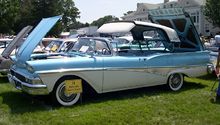Ford Fairlane Skyliner
The Ford Fairlane Skyliner is the coupé-cabriolet version of the Fairlane range . Its special roof made it world famous, because it was the first hardtop in the world that could be completely retracted into the trunk in one piece (first vehicle with an electric retractable hardtop : Peugeot 401 Eclipse, 1935).
The Ford Fairlane 500 Skyliner came on the market in 1957 as a sister model of the Sunliner convertible, which was still offered with a normal fabric hood. According to the advertising, the Skyliner should also appeal to customers who were not satisfied with a fabric hood and did not want to do without the comfort of a steel roof.
The roof technology was originally conceived for Lincoln, but since the vehicles of this brand were already too costly, the roof mechanism was finally used at Ford, where one could also imagine an economic success due to the higher sales figures.
It was lovingly staged in advertising and its technology was explained. Lucille Ball and her husband Dezi Arnaz (both known from the successful "I Love Lucy" show in America, at the time under an advertising contract with Ford) also put him in the limelight.
Visually largely identical to the Fairlane family, the Fairlane 500 Skyliner had some differences that were not immediately noticeable. The frame was designed completely differently, as space had to be created in the trunk for the steel roof, and the rear part of the vehicle was also longer than on all other Ford models. The filler neck, which is usually behind the license plate, is located on the Skyliner on the rear fender on the driver's side.
With 10 relays, 11 sensors and 7 small electric motors, the top was completely raised about 15 cm and then moved backwards. The power requirement was no greater than that of the conventional convertible. With the roof closed, the trunk offered a volume that you could comfortably sleep in. However, there was still the problem that the roof did not fill the storage space, but made it absolutely inaccessible. So that an inexperienced driver of the car did not overestimate the trunk volume, Ford installed a metal container on request, in which there was enough space for 3 fully packed travel bags. The customer was also able to order a so-called "Luggage Saver" suitcase set from the range of accessories.
The Skyliner was manufactured in the USA during the convertible boom. The 1957 model was built according to the taste of the time, it had many curves, extreme dimensions and still looked simple and noble. To the layman it looked almost like the sister model of the Ford Thunderbird , but it was still a real Fairlane, so it had little in common with the T-Bird.
Although the Skyliner with the roof offered a technical masterpiece, it suffered from many problems with the rather fragile technology. If only one sensor should fail or an electric motor received a wrong signal, the whole process would be aborted even in the middle of the opening or closing process or, if things got worse, the roof would remain in the position in which it had stopped. So if you saw a Skyliner driving through the streets with a half-open roof, it wasn't a publicity stunt, but rather a sign that there was another problem with the technology. The car, which is over 5 meters long and 2 meters wide, was intended to be an answer to the large convertibles from Cadillac , Chevrolet and Buick , which it succeeded for the most part if it weren't for the vulnerable technology.
Otherwise, like the "rest" of the large convertibles, it offered every imaginable extra that could be imagined at the time. With the 5.7-liter V8 engine, the car achieved decent performance for typical American " cruising ". Also typically American, there was no sparing with chrome, which also made it an eye-catcher. The Ford Fairlane Skyliner, however, became a sought-after classic car in the USA and Europe, primarily because of its roof construction, which achieves far higher collector prices than comparable convertibles with a conventional roof.
